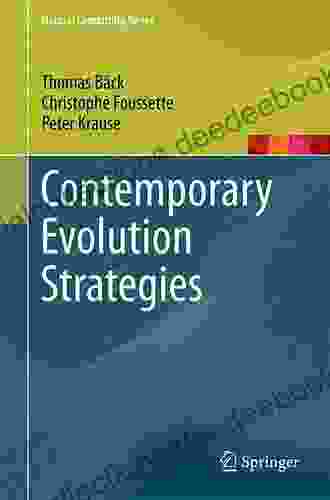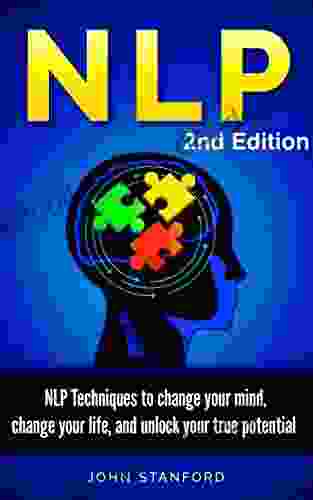Contemporary Evolution Strategies: A Natural Computing Series

Evolution strategies (ES) are a class of nature-inspired optimization algorithms that belong to the broader family of evolutionary computation (EC) techniques. Inspired by the principles of biological evolution, ES aims to find optimal or near-optimal solutions to complex optimization problems by simulating the process of natural selection.
4.5 out of 5
| Language | : | English |
| File size | : | 5092 KB |
| Text-to-Speech | : | Enabled |
| Screen Reader | : | Supported |
| Enhanced typesetting | : | Enabled |
| Print length | : | 164 pages |
ES operates by maintaining a population of candidate solutions, each represented by a set of parameters. These solutions are then evaluated based on their fitness, which corresponds to the objective function of the optimization problem. The fittest solutions are then selected for reproduction, and new solutions are generated through recombination and mutation operators.
Over multiple generations, ES iteratively evolves the population to improve the overall fitness of the solutions. By combining the principles of natural selection with powerful computational techniques, ES has emerged as a versatile and effective approach to solving a wide range of real-world problems.
Historical Perspective
The origins of ES can be traced back to the 1960s, with the pioneering work of Ingo Rechenberg and Hans-Paul Schwefel in Germany. They independently developed ES algorithms for solving complex optimization problems in engineering design and numerical optimization.
In the subsequent decades, ES underwent significant advancements, with researchers exploring various strategies for selection, recombination, and mutation. The of adaptive mechanisms, such as covariance matrix adaptation or self-adaptation, further enhanced the performance of ES algorithms.
Today, ES is widely recognized as a powerful optimization technique, with applications in diverse fields, including machine learning, artificial intelligence, robotics, and finance.
Principles of Evolution Strategies
The operation of ES algorithms is governed by several key principles:
- Population: ES maintains a population of candidate solutions, each represented by a set of parameters.
- Fitness evaluation: Each solution is evaluated based on its fitness, which is determined by the objective function of the optimization problem.
- Selection: The fittest solutions are selected for reproduction based on a predetermined selection strategy.
- Recombination: The selected solutions are combined through crossover or other recombination operators to generate new solutions.
- Mutation: The new solutions undergo random mutations to introduce diversity into the population.
- Iteration: The process of selection, recombination, and mutation is repeated over multiple generations to evolve the population.
By simulating the process of natural selection and incorporating computational techniques, ES algorithms can efficiently search for optimal solutions within a complex search space.
Strengths and Limitations of Evolution Strategies
ES offers several advantages as an optimization technique:
- Robustness: ES is less prone to becoming trapped in local optima compared to traditional optimization methods.
- Simplicity: ES algorithms are relatively easy to implement and understand.
- Parallelizability: ES can be efficiently parallelized to leverage multi-core processors or distributed computing environments.
- Noise tolerance: ES can handle noisy or uncertain objective functions, making it suitable for real-world applications.
However, ES also has some limitations:
- Convergence speed: ES may require a large number of generations to converge to optimal solutions, especially for complex problems.
- Initialization: The initial population can significantly impact the performance of ES, and choosing appropriate initialization strategies is crucial.
- Computational cost: ES can be computationally expensive, especially for large-scale optimization problems.
Applications of Evolution Strategies
ES has been successfully applied to a wide range of optimization problems across diverse domains:
- Engineering design: Optimizing the design of aircraft wings, automotive engines, and other engineering systems.
- Financial optimization: Portfolio optimization, risk management, and algorithmic trading.
- Machine learning: Hyperparameter tuning for machine learning models, neural network training.
- Robotics: Motion planning, control optimization for autonomous robots.
- Bioinformatics: Protein folding, DNA sequence analysis, and drug discovery.
Contemporary evolution strategies (ES) are a powerful and versatile class of nature-inspired optimization algorithms that have proven effective in solving complex problems across different disciplines. By simulating the principles of natural selection and utilizing computational techniques, ES can efficiently search for optimal solutions within complex search spaces.
While ES offers advantages such as robustness, simplicity, and parallelizability, it also has limitations, including convergence speed, initialization sensitivity, and computational cost. Nevertheless, ES remains a valuable tool for researchers and practitioners seeking to solve challenging optimization problems in a wide range of applications.
As the field of natural computing continues to advance, we can expect further developments in ES algorithms, including new selection strategies, recombination operators, and adaptive mechanisms. These advancements will further enhance the capabilities of ES and expand its applicability to even more complex optimization challenges.
4.5 out of 5
| Language | : | English |
| File size | : | 5092 KB |
| Text-to-Speech | : | Enabled |
| Screen Reader | : | Supported |
| Enhanced typesetting | : | Enabled |
| Print length | : | 164 pages |
Do you want to contribute by writing guest posts on this blog?
Please contact us and send us a resume of previous articles that you have written.
 Novel
Novel Text
Text Genre
Genre Library
Library Magazine
Magazine Newspaper
Newspaper Paragraph
Paragraph Sentence
Sentence Bookmark
Bookmark Shelf
Shelf Glossary
Glossary Foreword
Foreword Annotation
Annotation Footnote
Footnote Manuscript
Manuscript Scroll
Scroll Tome
Tome Classics
Classics Library card
Library card Narrative
Narrative Biography
Biography Memoir
Memoir Encyclopedia
Encyclopedia Narrator
Narrator Card Catalog
Card Catalog Stacks
Stacks Periodicals
Periodicals Study
Study Research
Research Lending
Lending Academic
Academic Reading Room
Reading Room Rare Books
Rare Books Special Collections
Special Collections Literacy
Literacy Thesis
Thesis Dissertation
Dissertation Reading List
Reading List Book Club
Book Club Theory
Theory Abe Kass
Abe Kass Sabine Durrant
Sabine Durrant Pat Garofalo
Pat Garofalo Hannah Hunter
Hannah Hunter Aanewyork
Aanewyork Shristuti Srirapu
Shristuti Srirapu Sarah E Fiarman
Sarah E Fiarman Paul O Mahony
Paul O Mahony Gary Berntsen
Gary Berntsen Paul Sanghera
Paul Sanghera D L Miller
D L Miller Annie Holmes
Annie Holmes Regpub
Regpub Moy Mackay
Moy Mackay Beatrice Edwards
Beatrice Edwards Caryn Lee
Caryn Lee James Buice
James Buice Jonathan D Green
Jonathan D Green Stephen Prince
Stephen Prince Jayden Burns
Jayden Burns
Light bulbAdvertise smarter! Our strategic ad space ensures maximum exposure. Reserve your spot today!
 Gil TurnerFollow ·9.8k
Gil TurnerFollow ·9.8k Raymond ChandlerFollow ·15.4k
Raymond ChandlerFollow ·15.4k John Dos PassosFollow ·18.2k
John Dos PassosFollow ·18.2k Donald WardFollow ·14.2k
Donald WardFollow ·14.2k Junot DíazFollow ·10.7k
Junot DíazFollow ·10.7k David BaldacciFollow ·2.1k
David BaldacciFollow ·2.1k Edwin CoxFollow ·11.3k
Edwin CoxFollow ·11.3k Bryce FosterFollow ·14.9k
Bryce FosterFollow ·14.9k

 Andy Hayes
Andy HayesEmbracing Now: Embark on a Mindfulness Journey for a...
In a world...

 Heath Powell
Heath Powell100 Hymns for Violin and Guitar: A Comprehensive Guide to...
The violin and...

 Floyd Richardson
Floyd RichardsonBark In The Park: Poems For Dog Lovers
Dogs are our best...

 Douglas Adams
Douglas AdamsThe Barter Crusade: A Journey into the Realm of Exchange...
In a world driven by monetary transactions,...

 Nathaniel Hawthorne
Nathaniel HawthorneInsight Guides Explore Nice & the French Riviera...
Prepare to embark on an unforgettable journey...

 Carlos Fuentes
Carlos FuentesThe Ultimate Practical Guide to Percussion: Exploring the...
Embark on a journey into the enchanting...
4.5 out of 5
| Language | : | English |
| File size | : | 5092 KB |
| Text-to-Speech | : | Enabled |
| Screen Reader | : | Supported |
| Enhanced typesetting | : | Enabled |
| Print length | : | 164 pages |












